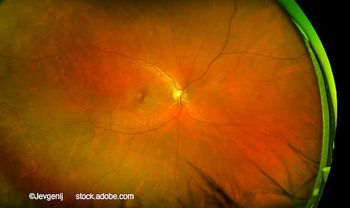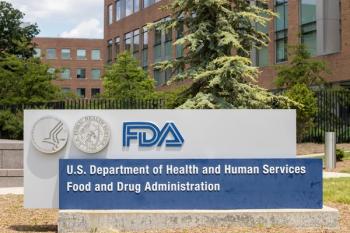
Study: Sodium hyaluronate solution safe, effective
An investigational compound for the treatment of dry eye disease consisting of a proprietary formulation of sodium hyaluronate ophthalmic solution 0.18% (Vismed, Lantibio Inc.) was shown to be safe and effective in a multicenter phase III trial conducted in the United States. A new drug application has been filed for the solution, which is already marketed in parts of Europe and Asia as a viscoelastic lubricant eye drop.
Key Points
Fort Lauderdale, FL-A multicenter, phase III pivotal trial demonstrated the safety and efficacy of a proprietary formulation of sodium hyaluronate ophthalmic solution 0.18% (Vismed, Lantibio Inc.) compared with its vehicle for the treatment of the signs and symptoms of dry eye disease, according to Charles A. Kirby, MD.
A member of the Vismed Study Group, he presented the findings at the annual meeting of the Association for Research in Vision and Ophthalmology. Sodium hyaluronate is approved for use as a viscoelastic during ophthalmic surgery.
"This study was able to show both an objective and a subjective improvement in patients with dry eye disease in which the sodium hyaluronate ophthalmic solution 0.18%, the active study drug, was better than the vehicle," said Dr. Kirby, an ophthalmologist in private practice in Chattanooga, TN. "The sodium hyaluronate ophthalmic solution 0.18% was found to be effective very quickly. Significant improvement in the lissamine green staining and also significant improvement in the symptomatology were found at day 7 and were maintained through day 14 for lissamine green staining."
The placebo-controlled, double-masked trial was conducted at 15 sites and enrolled 444 subjects with dry eye disease; 221 received the active study drug, sodium hyaluronate ophthalmic solution 0.18%, and 223 were randomly assigned to receive the vehicle control. The subjects instilled one to two drops of the study drug into each eye three to six times daily for 14 days; evaluations were performed at days 7 and 14, he said.
The study began in late 2006 and was completed in spring 2008. The subjects were aged 18 or more years and had a documented history of dry eye disease for at least 3 months. The majority (333) of subjects were female, and the mean age of all subjects was 61.5 years.
The two primary efficacy endpoints were an objective endpoint-mean change from baseline to day 7 in lissamine green staining scores of the cornea, nasal conjunctiva, and temporal conjunctiva-and a subjective one: mean change from baseline to day 7 in the summed scores for global symptom frequency in both eyes (soreness, scratchiness, dryness, grittiness, and burning). Results were analyzed using the Wilcoxon rank sum test and the student's t-test.
Significant results
The results showed that the difference of the means in the change from baseline to day 7 in lissamine green staining scores between the active and vehicle arms of the study was statistically significant using the t-test (p = 0.0291) and essentially significant (p = 0.0502) using the Wilcoxon rank sum test, Dr. Kirby said. The amount of mean change in the lissamine green staining scores was –1.1 for the active study drug and –0.7 for the vehicle, which was a 57% greater decrease for the active study drug.
The mean scores for lissamine green staining at baseline, on a scale of 0 to 12, were 5.71 in the active treatment group and 5.52 in subjects randomly assigned to vehicle. At day 7, the scores were 4.61 and 4.82, respectively. At day 14, the difference in means from baseline for lissamine green staining scores was –1.4 for the active study drug and –1.0 for the vehicle. These results also were statistically significant (p = 0.0243 using the t-test; p = 0.0461 using the Wilcoxon test).
The global symptom frequency score was the sum of five symptoms that were graded on a scale of 0 to 3: soreness, scratchiness, dryness, grittiness, and burning, he said. The mean baseline sum scores were 8.33 for the active study drug and 8.22 for the vehicle. At day 7, the respective scores were 6.63 and 7.12.
A statistically significant improvement was seen with both tests for the mean change from baseline to day 7 in the summed scores for global symptom frequency. The mean change of –1.7 for the active study drug and –1.1 for the vehicle had a p = 0.0173 for the t-test and a p = 0.0497 for the Wilcoxon test. This result was a 54.5% greater decrease for the active study drug, Dr. Kirby said.
European and Asian trials
In controlled clinical studies of the solution conducted in Europe and Asia, improvement has been observed in objective signs of dry eye disease, including corneal staining with fluorescein, staining with lissamine green, tear film break-up time, and impression cytology of conjunctival cells. The subjective symptoms of pain, soreness, scratchiness, grittiness, burning, photophobia, and comfort of the solution also were improved, he said.
In these European and Asian trials, the solution was safe and well tolerated; no adverse reactions were observed by the investigators or reported by patients.
In the phase III study conducted in the United States, the adverse events reported were not significant and were similar between the active drug and the vehicle, Dr. Kirby said. The most frequently reported adverse events were dry eye, eye pain, and foreign body sensation.
Newsletter
Don’t miss out—get Ophthalmology Times updates on the latest clinical advancements and expert interviews, straight to your inbox.



















































.png)


